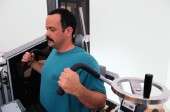Exercise could help disabled people, but too few are active, CDC reports

(HealthDay)—Half of the 21 million Americans who have a disability don't exercise, and that lack of exercise is jeopardizing their health, federal officials reported Tuesday.
Among these 11 million inactive adults are people who have difficulty walking or climbing stairs, have problems hearing or seeing, or have trouble concentrating, remembering or making decisions, officials said.
Many of these disabled adults are able to exercise, but don't do so regularly or at all, Ileana Arias, principal deputy director at the U.S. Centers for Disease Control and Prevention, said during a news conference.
"We are very concerned about this, because working-age adults with disabilities who get no aerobic physical activity are 50 percent more likely to have cancer, diabetes, stroke or heart disease than those who get the recommended amount of physical activity," Arias said.
"We know that regular aerobic physical activity increases heart and lung function, improves daily living activities and independence, decreases the chance of developing chronic diseases and also improves mental health," Arias said. "If doctors and health professionals recommend aerobic physical activity to adults with disabilities, then adults with disabilities are 82 percent more likely to be physically active," she added.
Speaking at the news conference, Dianna Carroll, an epidemiologist in CDC's Division of Nutrition, Physical Activity and Obesity, said, "We don't know if disability leads to inactivity and chronic disease, or if inactivity and chronic disease lead to disability."
What's clear, she said, is that exercise has the potential to prevent chronic disease, improve the health of someone with a chronic disease and help reduce the risk of additional chronic diseases.
But, 47 percent of adults with disabilities who are able to do aerobic physical activity don't do so. An additional 22 percent aren't active enough. Yet, only 44 percent of these adults who saw a doctor in the past year left with a recommendation to exercise, Carroll said.
According to Carroll, 57 percent of adults with limited mobility, 40 percent of adults with memory and thinking problems, 36 percent of those with serious vision problems and 33 percent of those with serious hearing difficulties get no aerobic exercise.
That's in contrast to the 26 percent of adults who don't have a disability and get no exercise, she added.
Carroll noted that government guidelines for Americans recommend that all adults, including those with disabilities, get at least 150 minutes—2.5 hours—of moderate aerobic physical activity each week.
If some people with disabilities can't reach this goal, they should do the best they can. The key is to avoid inactivity, Carroll said. "Some activity is better than none," she said.
People should start slowly, and exercise for at least 10 minutes each time. They should gradually increase their activity to reach the goal of at least 2.5 hours a week of moderate exercise, Carroll said.
Activities can include walking, swimming and biking. Even rolling yourself in a wheelchair is exercise, she said.
People with disabilities can encounter barriers that deter them from exercising. These include physical barriers such as no curb-cuts on sidewalks, no ramps into gyms, and parks and trails that aren't safe or easy to navigate, Carroll said.
She also said psychological barriers play a role. These include lack of support from family and friends or feeling self-conscious about using a gym and asking for help.
People with disabilities need to develop the confidence and the belief in their ability to do aerobic exercise as a way of improving their health, Arias said.
Samantha Heller, a senior clinical nutritionist and exercise physiologist at NYU Langone Medical Center in New York City, said, "For some people with disabilities, the idea of movement and exercise is daunting and they do not know how or where to begin."
Health professionals can take a proactive approach with their patients with disabilities by referring them for physical or occupational therapy, she said.
"Physical and occupational therapy are terrific places for people with disabilities to kick-start their exercise programs. Patients, too, can be proactive in their own health care and demand referrals for physical or occupational therapy," Heller said.
Depending on the type and level of disability, exercise options may include aquatic exercise, chair yoga, adapted Tai Chi, wall push-ups, balance exercises and stability ball exercises, she said.
More information: Visit the U.S. Centers for Disease Control and Prevention for more on physical activity.
Copyright © 2014 HealthDay. All rights reserved.

















